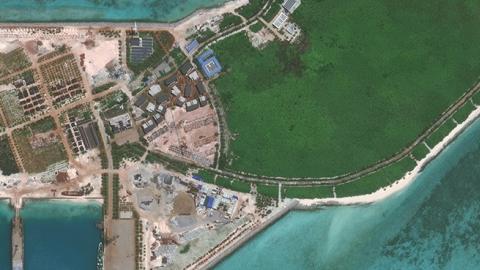“This is China warship calling,” a voice bellowed out over the radio. “The Nansha islands are under Chinese sovereignty. What are your intentions?” The reply from the French military vessel, where I was on the command bridge as an observer last week, was polite but curt. The French said their ships were operating in international waters. We were passing through the disputed Spratly Islands of the South China Sea when the Chinese frigate dialed in. It would not be our last encounter.
Several Chinese frigates and corvettes closely tailed our passage around Mischief, Subi and Fiery Cross Reefs. Those specks of land have popped up in international headlines in recent years as Beijing has transformed them into artificial islands with airstrips and military installations.
This past weekend at the Shangri-la Dialogue, U.S. Defense Secretary Jim Mattis called out China’s aggression as breaking Xi Jinping’s promises. “China’s militarization of the Spratlys,” Mr. Mattis said, is in “direct contradiction to President Xi’s 2015 public assurances in the White House Rose Garden that they would not do this.”
Backing up American words, the U.S. rescinded China’s invitation to participate in joint military exercises in the Pacific. The U.S. Navy also conducted its own freedom-of-navigation operation in the disputed Paracel Islands, on which China recently landed a strategic bomber. Still, the Trump administration has not presented a broader strategy to counter China. What is sure is that the U.S. could use allied assistance.
Americans are used to hearing about lazy European allies unwilling to pay for their own defense. They should consider the French action. Since 2014, France has sailed regularly through the South China Sea to uphold freedom of navigation. France remains a naval power that can project force out of its overseas territories, including French Polynesia, New Caledonia and Réunion Island. President Emmanuel Macron is building stronger defense relationships with India and Australia, and he seems to be realistically assessing the growing Chinese challenge. This is a welcome change from his predecessors, who were enthralled by the business and investment opportunities in China.
France is rallying other Europeans to put action behind the declarations of free navigation. That was the message at the Shangri-la Dialogue from French Defense Minister Florence Parly. “The fait accompli is not a fait accepted,” she said, a clear reference to Chinese attempts to deny international access to disputed waters. France’s missions could be the foundation for a multinational European operation. European Union leaders remain split on how to approach China. But as a first step, the French warship I was on included a U.K. helicopter detachment and European observers, including from Germany.
China tries to frame the freedom-of-navigation operations as driven by U.S. expansionism. That’s why Beijing protests American exercises while giving those by France, Australia and the U.K. a pass. Even an increasing number of Western operations might not break China’s de facto stranglehold on the South China Sea. But as French warships have now demonstrated, the coalition for free navigation is growing.















